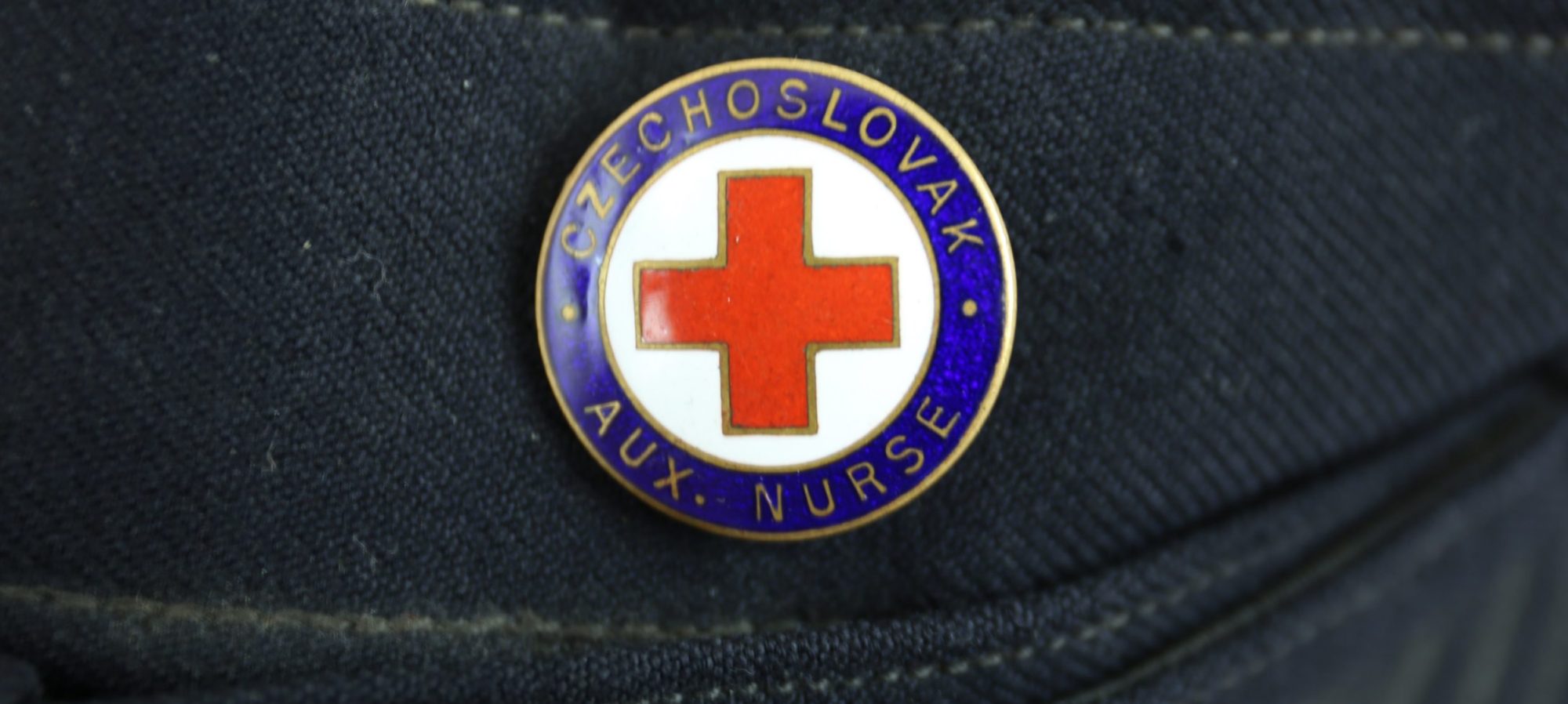- Panel – NURSES OF THE CZECHOSLOVAK RED CROSS
…………IN GREAT BRITAIN 1939–1945 - Panel – Assistance to compatriots
- Panel – Nursing Department and nursing courses
- Panel – S.R.N. – State Registered Nurse
- Panel – Location of Czechoslovak nurses
- Panel – CRC nurse uniforms
- Panel – Components of the uniform of Emília Součková
- Panel – Medical expeditions
- Panel – Marie Rechtová
- Panel – Period Press
NURSES OF THE CZECHOSLOVAK RED CROSS IN GREAT BRITAIN 1939–1945
“Most of us women emigrated in the belief that we would be able to help in some way to liberate our country. Many left their homes and their families.”
There are still forgotten chapters in the history of Czechoslovakia. One of them is the Czechoslovak women who helped and worked as nurses of the Czechoslovak Red Cross (“CRC”) in exile in Great Britain (GB) during World War II. Czechoslovak women working in Western exile were deliberately neglected for 40 years, no less so were the activities of the CRC during World War II. Those who served in the British army have already achieved some satisfaction; their destinies have been more or less recorded. The exhibition is mainly a reminder of Czechoslovak women nurses of the Czechoslovak Republic, about whom we still know relatively little. In addition to the archival material, which is extensive though not complete, only a few brief memories of nurses have been preserved or are still undiscovered by researchers.
In the interwar period, most emigrants left for economic reasons. They left their homes to pursue the vision of a new, better life, for a temporary job or to learn a language. Service in English families was the most common opportunity for Czechoslovak women. After the rise of Nazism in Germany in the 1930s, many emigrants left for political, religious or racial reasons. Czechoslovak women left with their families or alone with the help of Czechoslovak or British humanitarian organizations established for this purpose. Two nurses said they had gone to GB in a child transport. Many Czechoslovak women after arriving in GB or after an appeal in the media after the establishment of the Protectorate of Bohemia and Moravia in March 1939 signed a statement at the Czechoslovak Embassy that they would be called free of charge to any service to help liberate the homeland. Once the war started, over 400 Czechoslovak women were registered. Initially, if they received a work permit, they earned money as domestic helpers, factory workers, office clerks in agricultural, while others worked as nurses in British hospitals. It was not until 1941 that the British authorities allowed female members of the Allied states to join the women’s army corps. Czechoslovak women’s associations were also established in GB, which organized various events or collections to support Czechoslovak soldiers and refugees. The members of these associations were also Czechoslovak Red Cross (CRC) nurses. It was not easy for many immigrants. They had left home and found themselves in a foreign country, often without knowledge of the language. If they hadn’t acquired the basics of the English language while studying at home or during temporary work, the new situation forced them to learn English from scratch. Knowledge of the language made it easier for them to get a job.
Visit the Facebook page of the Nurse of the Czechoslovak Red Cross 1940–1945 or aux-nurse.cz and follow the posts about new discoveries in the archives and beyond, and you may find out that your grandmother worked in GB during the war as a nurse of the Czechoslovak Red Cross.
The exhibition was prepared by:
Association of Czechoslovak Legionnaires
The realization of the exhibition involved:
Ministry of Defence of the Czech Republic
Text:
Petra Suková
Assistance with creating this exhibition was provided by:
Julia Albert-Recht, Adri Czanner, Anna Czannerová, Mirka Czannerová, Jaroslav Diviš, Milan Dudešek, Natálie Eretová, Vilém Fencl, Jiří Charfreitag, Milan Hájek, Ruth Hálová, Štěpán Hodek, Judita Hodková, Eva Houštecká, Iveta Hrubá, Tomáš Jambor, Alexandra Kučerová, Jana Kykalová, Michal Lukšíček, Michal Makaj, Judita Matyášová, Zuzana Palová, Lucie Plecitá, Jana Poncarová, Ivan Procházka, Adam Recht, Marie Rechtová, Martin Říha, Vladislav Severin, Zdenka Shorná, Honza Suk, Jan Suk, Anna Suková, Pavla Šafaříková, Ladislav Šilhavý, Zdeněk Špitálník, Jaroslav Špitálský, Petr Šraier, Petr Tolar, Milan Varták, Hana Velecká, Scott Velan, Lukáš Víšek, Marcela Volfová, Dana Vrtišková, Markéta Zahoranová and Helena Žáková
Photographs and documents from the collections were provided by:
Archive of the Ministry of Foreign Affairs of the Czech Republic
National Archives of the Czech Republic
Julia Albert-Recht, Milan Hájek, Ruth Hálová, Tomáš Jambor, Petra Suková, Scott Velan
Graphics:
Martin “Horka” Říha
